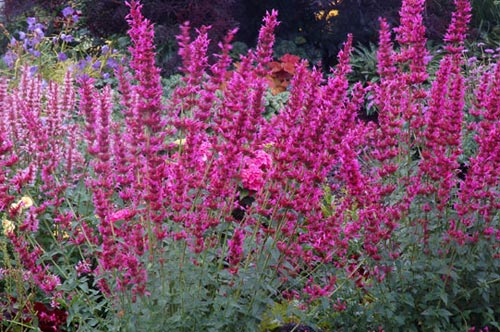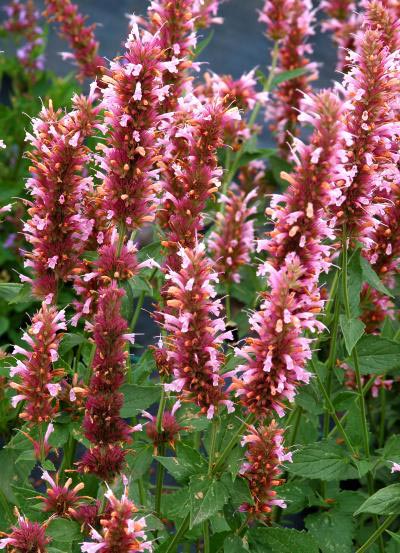The Latin name comes from the Greek: "aga" meaning "very much" and "stachys" meaning "ears of wheat."
Not many plants can offer as much for the buck as Agastache. While it's hard to pronounce, (try "uh-gas-tuck-ee"), the payoff is in myriad spikes of a rainbow of colors over really aromatic foliage. The common name of Anise-Hyssop does bring up images of a Harvey Wallbanger with a spring of mint, or licorice and mint to the under 21 crowd. This plant is in the mint family, dying to the ground in winter and pushing up strongly in spring. While some are extremely hardy, you'll have to pay attention to the hardiness zones listed. Even in Northern zones, you can grow Agastaches as annuals, as they bloom beautifully from July till first frost.
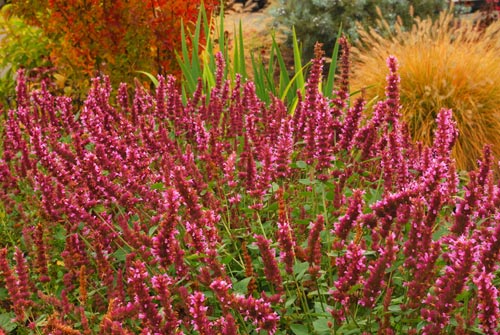 Fall in Oregon |
IN THE GARDEN
Everblooming plants can be a blessing or a curse depending on how much maintenance they require. Fortunately Agastache are easy to work into the landscape with only a little care. (minor dead-heading) They are also great in containers, as they offer a floral color range that offers accents to so many other plants. They are all very drought-resistant, so missing a watering won't hurt a thing.
Grasses are the perfect complement. Fescues and Helictotrichon offer ice-blue foliage contrast. Pennisetum are a natural, especially the forms with summer and fall red foliage like Pennisetum rubrum (annual). Panicum virgatum 'Rotstrahl' is a hardy red form at the top of my list for this purpose.
A mass of Agastache combined with all these elements is pleasing to the eyes and nose and also to insects and wildlife.
WILDLIFE
The term 'hummingbird-magnet' is often applied to the nectar rich flowers. I did notice that they had their preferences in a California Garden I was visiting. The owner and I saw that they were virtually dive bombing the southern species while barely touching other forms. The nursery owner quipped, "Oh, they prefer Mexican food!" Bees and butterflies are also common visitors. It is not uncommon to see aviary owners planting Agastache near their hives to feed the bees with the copious pollen and nectar.
A Massachusetts nursery came up with the clever phrase, "the buck doesn't stop here!" - Testimony that the fragrant foliage is not attractive to chewing critters like deer. While some people use the fragrant leaves in tea, Agastache have been used as healing herbs by the Chinese and Native Americans for centuries.
COLOR RANGE
The form of the plants can vary from almost needle-like small leaves and spiky flowers (A. rupestris) to full, fat leaves, with broad flower heads (A. rugosa). While the USDA lists 16 North American species, most of the come from Arizona, New Mexico, Texas, and Northern Mexico. Others are from places as diverse as Korea and Europe. Each new discovery can be brought into the breeding pool to extend color range and adaptability to different regions. The color range is impressive from golds, through pastel salmon and apricot shades to pink and red flowered forms. Newer forms are nearly raspberry-red to magenta and Agastache rugosa from Korea which has been used in blue-flowered forms like A. 'Blue Fortune'. Some forms are beautifully bicolored, fading between oranges and reds.
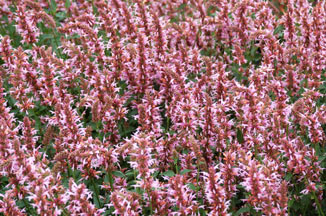 Agastache 'Cotton Candy' en masse |
AGASTACHE CULTURE
While on a recent trip to New Mexico, I was observing how well Agastache tolerated amazing heat and drought conditions. Plants were half the size of our Pacific Northwest specimens due to soils of differing pH and rainfall. The Southwest soils are, at many times, both sandy and alkaline, but I have found these plants to be tolerant of a wide range of soil pH. Like Heuchera, they have a disdain for being planted too low, especially in rich clay. What they would prefer is a soil of moderate to lower fertility (too much nitrogen makes them stretch and flop over...) and drainage, drainage, drainage. Do plant their crowns above the soil surface or in a raised bed and they will flower their heads off as a thank you. Pruning - from High Country Gardens "To improve winter hardiness; leave the stems on the plants over the winter. In mid-spring, cut the dead stems off about 4 or 5 inches above ground level. In zone 5 & 6 areas of the country with wet winters, the southwestern species are best planted on sunny south or west facing slopes or in raised beds with sandy, fast-draining soil. The plant's crown should be planted high and then mulched with crushed gravel to keep it drier during cold, wet weather." Mildew is a problem with some varieties in humid, hot parts of the country.
We found that a haircut (remove 50% of the plant) in late July gave us a huge flush in September and continued till frost. As many Agastache "fade to brown" as the flowers age, it doesn't hurt to give them small haircuts to keep them looking neat. If you wish to share your plants, you can divide the clumps in spring or take cuttings in late spring. It's best not to take flowering stems as cuttings as they will mostly go to bloom. Some of the newer hybrids are sterile, which really bumps up their flower power. The species can go nearly weedy with so much seed, so there is another reason to deadhead the old flowers. As plants are not long-lived, it is a good idea to divide them with regularity or save some seedlings to keep the plant fresh and productive.
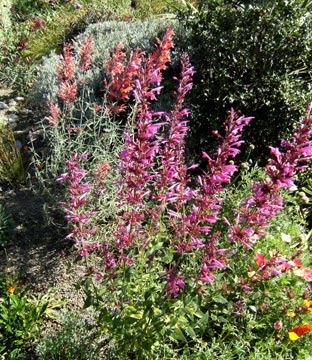 NW Garden Nursery / Dry Bed |
THE SPECIES
Agastache aurantiaca (Coronado mint)
Pale orange flowers, 2 to 3" high, strongly fragrant foliage. Hummingbird magnet. Zone 7-9
Agastache cana (Hummingbird mint)
Dark pink flowers, 2 to 3" high, Texas native. Zone 5-9
Agastache mexicana (Giant Mexican hyssop)
Pale pink to red flowers, 3" high, and Northern Mexico native. Zone 7-9
Agastache rugosa (Korean giant hyssop)
Violet blue flowers hover above 24”-30” plants, strong habit. Introduced by Dan Hinkley. Zone 5-9
Agastache rupestris (Sunset hyssop)
Fine gray leaves with salmon-tinted flowers, 3 feet tall. Zone 5-9
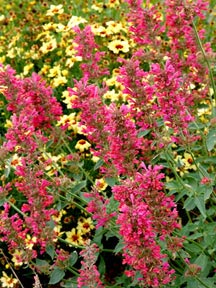 Agastache 'Raspberry Summer' |
BREEDING AGASTACHE
While there is much to enjoy from the straight species, there are the negatives: seediness, shorter bloom-time, and lack of color range. The hybrids have moved to the top of many gardeners' lists with their improvements. There are always different breeding "camps" with most any genus. The Dutch have been busy with a number of seed-grown varieties. These seed varieties were trialed with other international breeder's plants in 2003-04 with the Royal Horticultural Society in England (RHS) and none received an AGM. Seed varieties have the advantage of being very inexpensive but carry the aforementioned problems of seediness (go figure!) and poor growth habits. The exception seems to be A. 'Apricot Sprite' which is compact and floriferous, but lacks hardiness. Thompson and Morgan in the U.K. are working hard on developing a new color range from seed.
Plants from cuttings were trialed the same year at the RHS trials (objectives at the bottom of the page*) and 4 received an AGM (see below). All were hybrid. Here's a list of the 2004 winners:
- Agastache 'Blue Fortune' AGM
- Agastache Acapulco Salmon Rose Bicolor 'Kiegabi' AGM
- Agastache Acapulco Orange 'Kiegador' AGM
- Agastache 'Tangerine Dreams' AGM
Varieties with yellow or orange flowers are not as winter hardy. These colors come from A. aurantiaca. It and A. mexicana are native to Mexico. A. cana is native to New Mexico and Texas. Hardiness is improved with sandy soils and excellent drainage.
David Salman's High Country Gardens www.highcountrygardens.com has done some excellent work with stronger, hardier plants and a xerophytic angle. He currently offers 14 varieties including some of his own breeding work and some selected species.
A FEW GOOD HYBRIDS
Agastache Acapulco series
A range of colors on very dwarf plants (14"). Zones 5 to 10
Agastache 'Blue Fortune'
A strong hybrid of A. foeniculum and A. rugosa. Strong bloomer. Very resilient. Lighter blue flowers than A. rugosa. Zones 6 to 10
Agastache 'Desert Sunrise'
From High Country Gardens. Flowers are a melting blend of orange, pink and light purple. A biggy at 4' tall. Zones 5 to 10
Agastache 'Red Fortune' PPAF
Great hybrid with dark pink flowers and a dwarfer habit to 3' tall. Zones 7 to 11
Agastache 'Tutti-Frutti'
Dark red flowers atop 3' tall, upright plants. Fruit-scented, minty foliage. Zones 7 to 10
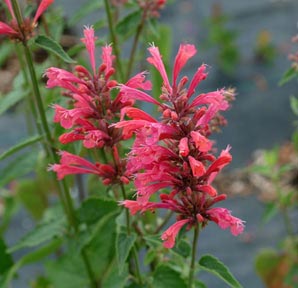 Agastache 'Raspberry Summer' |
Terra Nova® set the following breeder's goals for Agastache:
- More weather resistance
- The longest lasting flowers in the industry
- Non browning calyces mean longer lasting color
- Better habit for more garden and container uses
- Broad color palette (better for use as fillers and thrillers)
Typically 1500 plants will be produced from numerous crosses from which a few plants will be selected. These new hybrids have strong bushy habits, shorter stems, and dense flower spikes of a wide range of colors from blue to red to orange to yellow to pink.
Why TN Agastache are better:
- Large dense spikes
- Showy calyces which means longer lasting color
- Excellent habits for more garden and container uses
- Good weather resistance
- Broad color palette
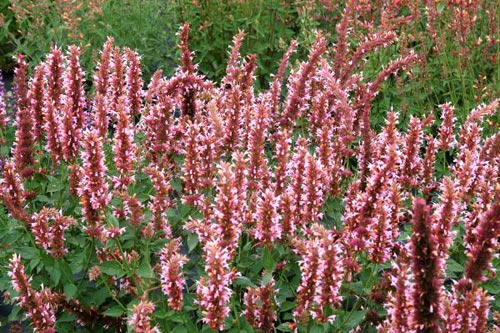 Agastache 'Cotton Candy' |
       |
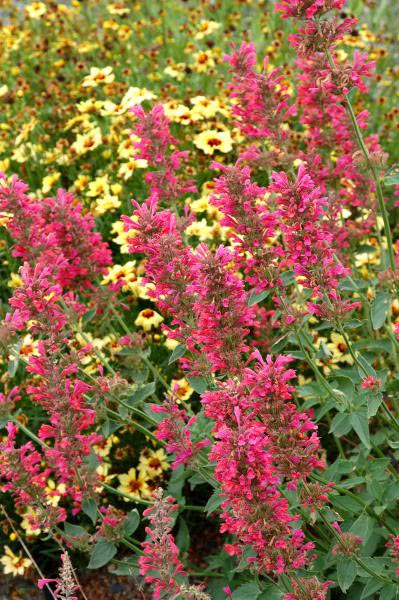 Agastache 'Raspberry Summer' |
       |
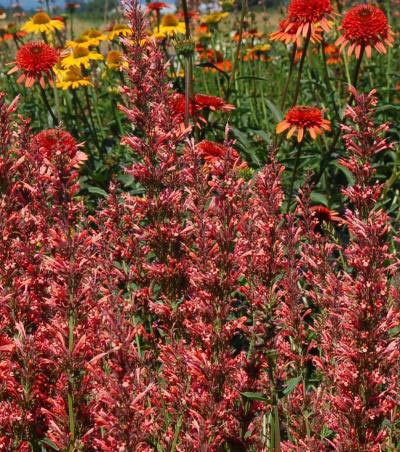 Agastache 'Summer Fiesta' |
       |
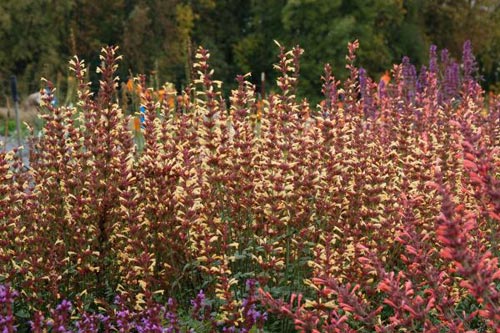 Agastache 'Summer Glow' |
       |
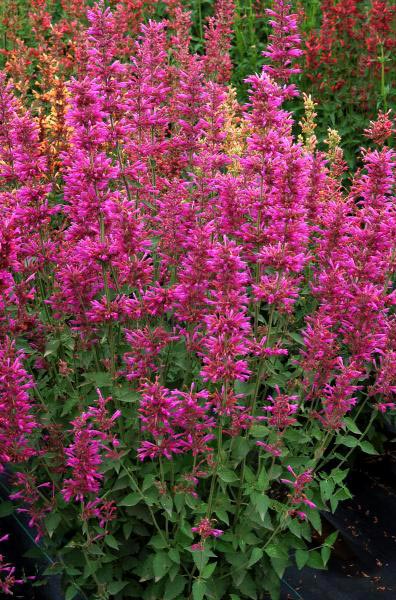 Agastache 'Summer Love' |
       |
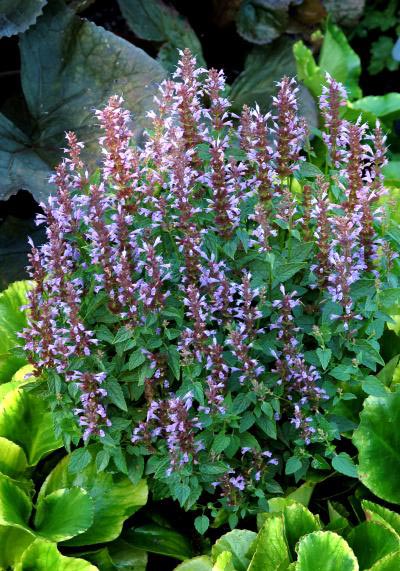 Agastache 'Summer Sky' |
       |
|
|||||||||||||||||||||||||||||
It"s time to give these wonderful plants a try!
NURSERY SOURCES
Avant Gardens
710 High Hill Road
North Dartmouth, MA 02747
508-998-8819
www.avantgardensne.com
Bluestone Perennials**
Order by phone: 1-800-852-5243
Customer Service: 1-800-852-5243
Fax: 1-800-852-5243
www.bluestoneperennials.com
Canyon Creek Nursery
3527 Dry Creek Road
Oroville, CA 95965
530-533-2166
www.canyoncreeknursery.com
Garden Crossings **
1-616-875-6355
www.gardencrossings.com
Goodwin Creek Gardens
P.O. Box 83
Williams, OR 97544
800-846-7359
www.goodwincreekgardens.com
High Country Gardens
2902 Rufina Street
Santa Fe, NM 87507
800-925-9387
www.highcountrygardens.com
Sooner Plant Farm, Inc. **
25976 S. 524 Rd.
Park Hill, OK. 74451
Office 918.453.0771
Fax 918.431.1700
www.soonerplantfarm.com
** Offers a larger selection of Terra Nova® Nurseries' plants
* RHS Objectives: To demonstrate and assess the habit, flowering performance and hardiness of a range of Agastache, commonly grown as summer bedding. In particular to trial those Agastache normally propagated vegetatively. It was also aimed to resolve nomenclatural problems within the genus and to trial new cultivars or those that have or are awaiting Plant Breeder's Rights.
Entries: 17 entries were submitted in the trial by
various nurseries in the UK and the Netherlands.
Findings: It was noted that Agastache tend to be perennial
in well-drained soil and even in clay, but few are fully hardy. A. rugosa
tends to be hardy but the shoots of Mexican types can be killed by late
April frosts causing the plants to die.
